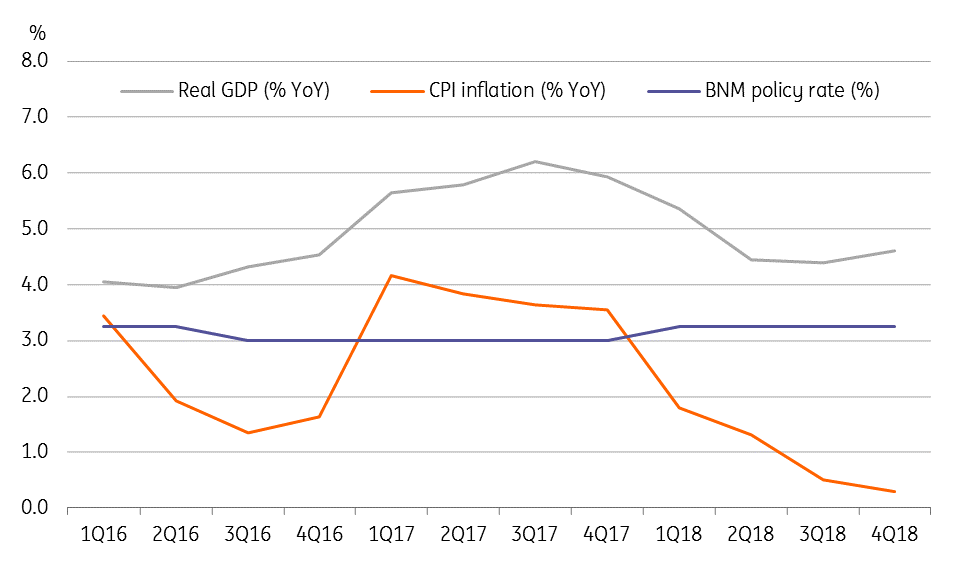Malaysia: Manufacturing boosts GDP growth
We believe that the central bank (BNM) considers the economic risks to be fairly balanced between growth and inflation and that it will keep monetary policy on hold this year
| 3.4% |
December industrial production growthYear-on-year |
| Higher than expected | |
Firmer exports, firmer manufacturing
Released today, Malaysia’s industrial production grew more than expected by 3.4% year-on-year in December, up from 2.6% growth in November (revised from 2.5%). The outcome was slightly short of our 3.5% growth forecast but way better than 2.7% consensus estimate. Our above-consensus estimate relied on firmer exports, especially electronics exports which have held up well in the face of a slowdown elsewhere in the region (Korea, Taiwan, Singapore).
Among the other activity indicators released alongside the production data, manufacturing sales growth eased slightly (7.5% in December vs. 7.7% in November) and employment growth slowed too (1.7% vs. 2.0%), yet salaries improved (10.1% vs. 9.0%).
Exports drive manufacturing

Acceleration of GDP growth in 4Q18
Industrial production growth closely tracks manufacturing GDP growth. At an average of 3.5% in the final quarter of 2018, IP growth accelerated from 2.3% in the third quarter. The growth of real manufacturing sales (deflated by the consumer price index), which loosely tracks services GDP growth, was steady around 8% over these periods. This is consistent with our view of an acceleration in GDP growth over the period to 4.6% year-on-year from 4.4%. The release of the 4Q18 GDP data is scheduled for Thursday, 14 February.
On the expenditure side, a positive contribution from net trade supported the acceleration of GDP growth in 4Q18. However, strong wage growth combined with low inflation likely sustained private consumption as the main GDP driver. This leaves government consumption and investments as possible weak links in the economy following restraints on public spending and the suspension of some infrastructure projects under the new government.
Central bank policy and currency outlook
We think the central bank (BNM) considers the economic risks fairly balanced between growth and inflation and will leave monetary policy on hold throughout 2019. The potential of a softer US dollar following a dovish turn in the US Federal Reserve's policy and firmer oil prices will be positive for the Malaysian ringgit (MYR).
The 1.6% year-to-date MYR appreciation against the US dollar puts it among Asian outperformers so far this year. We see the USD/MYR rate hovering around 4.10 for most of the year.
Balanced economic risks

Download
Download article
11 February 2019
Good MornING Asia - 12 February 2019 This bundle contains 3 Articles"THINK Outside" is a collection of specially commissioned content from third-party sources, such as economic think-tanks and academic institutions, that ING deems reliable and from non-research departments within ING. ING Bank N.V. ("ING") uses these sources to expand the range of opinions you can find on the THINK website. Some of these sources are not the property of or managed by ING, and therefore ING cannot always guarantee the correctness, completeness, actuality and quality of such sources, nor the availability at any given time of the data and information provided, and ING cannot accept any liability in this respect, insofar as this is permissible pursuant to the applicable laws and regulations.
This publication does not necessarily reflect the ING house view. This publication has been prepared solely for information purposes without regard to any particular user's investment objectives, financial situation, or means. The information in the publication is not an investment recommendation and it is not investment, legal or tax advice or an offer or solicitation to purchase or sell any financial instrument. Reasonable care has been taken to ensure that this publication is not untrue or misleading when published, but ING does not represent that it is accurate or complete. ING does not accept any liability for any direct, indirect or consequential loss arising from any use of this publication. Unless otherwise stated, any views, forecasts, or estimates are solely those of the author(s), as of the date of the publication and are subject to change without notice.
The distribution of this publication may be restricted by law or regulation in different jurisdictions and persons into whose possession this publication comes should inform themselves about, and observe, such restrictions.
Copyright and database rights protection exists in this report and it may not be reproduced, distributed or published by any person for any purpose without the prior express consent of ING. All rights are reserved.
ING Bank N.V. is authorised by the Dutch Central Bank and supervised by the European Central Bank (ECB), the Dutch Central Bank (DNB) and the Dutch Authority for the Financial Markets (AFM). ING Bank N.V. is incorporated in the Netherlands (Trade Register no. 33031431 Amsterdam).